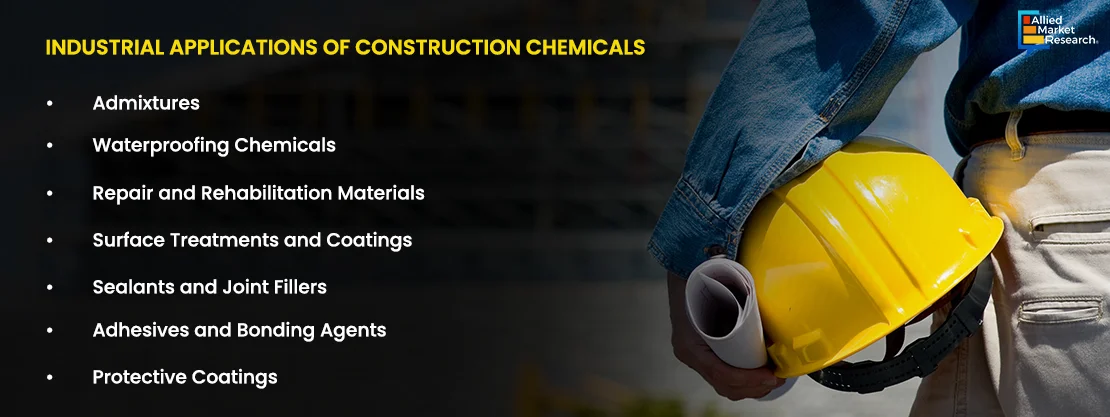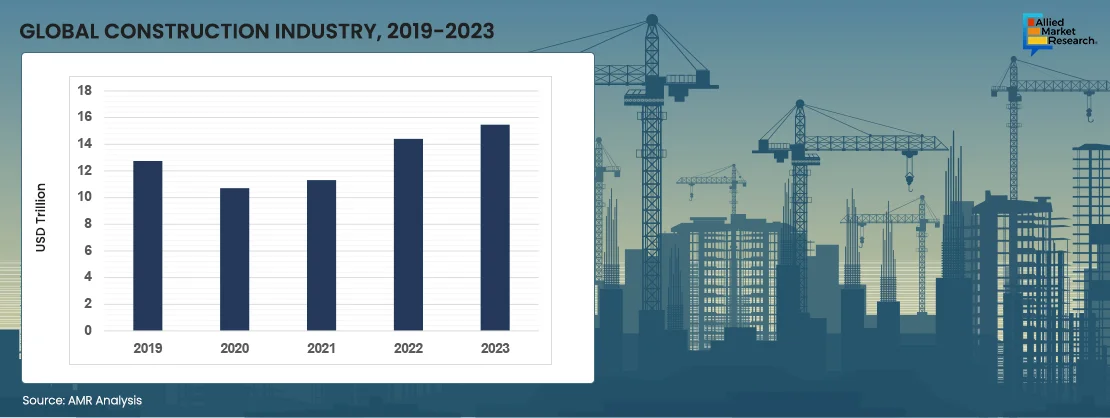Table Of Contents

Sonia Mutreja

Shraboni Sen
Risk Mitigation Analysis in Construction Chemicals Industry

Construction chemicals are chemical compounds that are used in the construction industry to improve the performance, durability, and functionality of construction materials & structures. These chemicals include a wide range of products such as adhesives, sealants, waterproofing compounds, concrete admixtures, and protective coatings, which enhance the properties of concrete, mortar, and other construction materials. They play crucial roles in various construction projects, including industrial, residential, and commercial buildings. For example, concrete admixtures are added to concrete to improve its workability, strength, and durability. Waterproofing compounds are applied to surfaces to prevent water penetration and damage, while protective coatings are used to protect surfaces from weathering, UV radiation, and chemical attack.
The construction chemical industry is thriving globally, driven by infrastructure development, urbanization, and increase in awareness of quality & safety in construction projects. Companies offer a wide range of construction chemicals for new and existing infrastructure applications. For instance, Sika AG provides a wide range of construction chemical products which are used in cement, repair & rehabilitation, insulation, waterproofing, flooring, and others. Moreover, the industry focuses on sustainable construction practices that use materials which are environmentally friendly, energy-efficient, and durable, leading to increased demand for construction chemicals that meet these requirements due to which its future growth trajectory remains promising. Examples include low-carbon concrete admixtures, sustainable waterproofing solutions, and environment-friendly coatings.
Industrial Applications of Construction Chemicals
Construction chemicals are utilized across diverse sectors of the construction industry, including residential, commercial, industrial, and infrastructure projects. They are applied in new construction as well as in the repair and maintenance of existing structures. The key types of construction chemicals and their applications include -

- Admixtures: These are chemical additives mixed with concrete, mortar, or grout to modify their properties. Admixtures enhance workability, accelerate or retard setting time, improve strength, reduce water content, and provide other desirable characteristics.
- Waterproofing Chemicals: These chemicals are used to prevent water ingress into structures, protecting them from moisture-related damage, such as corrosion, dampness, and mold growth.
- Repair and Rehabilitation Materials: These include products such as concrete repair mortars, epoxy coatings, and sealants used to repair and restore deteriorated concrete structures, extending their service life.
- Surface Treatments and Coatings: These chemicals are applied to concrete surfaces to provide protection against abrasion, chemical attack, staining, and UV degradation, while also enhancing aesthetics.
- Sealants and Joint Fillers: These materials are used to seal joints and gaps in construction materials, preventing water infiltration, air leakage, and the ingress of contaminants.
- Adhesives and Bonding Agents: These chemicals are used to improve the bond between various construction materials, facilitating the adhesion of coatings, toppings, tiles, and other finishes.
- Protective Coatings: These coatings provide protection against corrosion, chemical attack, and abrasion for steel structures, concrete surfaces, & other substrates.
Key Trends in the Construction Chemical Industry
The construction chemical industry is set to thrive in the years to come with rise in the number of construction projects in emerging countries. In addition, there is rise in demand for durable and sustainable construction materials that are able to withstand the challenges of urban environments as the cities are expanding and population is growing. This has led to an increased use of construction chemicals to enhance the strength, durability, and longevity of structures. Urbanization drives the need for infrastructure development, commercial spaces, and residential buildings. Governments and private entities invest in large-scale infrastructure projects such as roads, bridges, airports, and public facilities. These projects require specialized construction chemicals for durability, safety, and quality. Stakeholders have become more aware of the benefits of using high-quality construction materials. This awareness leads to a preference for construction chemicals that enhance structural integrity, protect against environmental factors, and improve overall performance.
Impeding Factors and Corresponding Solutions
The construction industry has been growing at a steady pace post COVID-19 pandemic. According to a study by Deloitte, “The construction industry entered 2023 marked by a 7% increase in nominal value added and a 6% increase in nominal gross output compared to 2022. As of the third quarter of 2023, nominal construction spending maintained a steady upward path.”

The above figure showcases the construction industry valuation between 2019 and 2023. In the financial year 2022-2023, the construction industry showcased normalized growth as compared to the recovery growth rate of more than 27% in financial year 2021-2022 post COVID-19 pandemic. This was observed in emerging economies such as China, India, Brazil, and Saudi Arabia. Construction expenditures in these countries in 2023 accounted for a major share in the global construction industry.
Construction Industry Challenges and Their Solutions
The construction industry faces a shortage of skilled labor, which is expected to worsen in the coming years. Lack of young professionals joining the construction industry and aging workforce coupled with lack of experienced professionals lead to a declining workforce in the construction industry globally. According to the U.S. Bureau of Labor Statistics, there were 363,000 new job openings in the construction industry in July 2023 as compared to 386,000 new job openings in July 2022. Young professionals have pre-conceived notions related to the blue-collar jobs mainly in the construction industry. To mitigate these issues, construction professionals (business owner and management committee) need to recruit individuals from local trade schools. Imparting training and skill development to them should be their highest priority, which can be conducted with ’training on the job program’. In addition, incentive program should be envisaged to seasoned professionals to retain them and provide them with bonuses accordingly. Such measures ensure that skilled labor is retained in the industry.
The construction industry is highly fragmented, with many different stakeholders involved in a project, including architects, engineers, contractors, subcontractors, and suppliers. Coordinating the adoption of technology across these diverse stakeholders is challenging. Many construction professionals are accustomed to traditional methods and are resistant to adopting new technologies due to fear of change or lack of understanding of the benefits. For mitigating these issues, encouraging collaboration & standardization across the industry streamlines the adoption of new technology (new products related to construction chemicals and machine automations). Developing common standards, interoperable systems, and collaboration platforms facilitate communication and information sharing among stakeholders. Providing comprehensive training and education programs to construction workers and management about the benefits and functionalities of new technologies help alleviate resistance and foster a culture of innovation.
Strategic Developments Impacting Construction Chemicals Industry
Major manufacturers in the construction chemical industry focus on different strategic developments to remain competitive. Merger & acquisition, agreements, new product launches, and expansion are some of the major initiatives undertaken by these companies. These initiatives help the manufacturers in the construction chemical industry to increase their market share by either offering new products catering to different applications and expanding their production capacity or establishment of their presence in new regions to cater high volume demands, or by acquiring rival organizations.
Magicrete, in March 2024, acquired Maxlite. Through this acquisition, Magicrete expanded its production capacity of AAC blocks to 1.8 million cubic meters annually and increased its presence in Southern India. Everest Systems launched EverMax Polyurea in October 2023. This product is a polyurea based flexible coating for commercial roofing applications. The product is suited for a variety of weather conditions, thereby making it a low maintenance and cost-effective solution for the built structure. In January 2024, Saint Gobain (France) acquired R.SOL (France) and Technical Finishes SA (Pty) Ltd. (South Africa). Saint Gobain’s acquisition of R.SOL is expected to enlarge its product portfolio related to resins and corresponding customer base. Furthermore, Saint Gobain’s acquisition of Technical Finishes SA (Pty) Ltd. is projected to enhance its product portfolio pertaining to resin flooring solutions in South Africa. These approaches by Saint Gobain are anticipated to strengthen its position mainly under their “Weber” brand in European and African region.
Future Outlook and Growth Scope
The key players in the construction chemical industry have undertaken numerous R&D efforts in innovating new product offerings for use in the construction industry. New industry goals such as ’Circular Economy’ and ’Zero Carbon’ raise the focus on bio-based products for sustainable approaches in the long run. Global economic conditions, technological advancements, and changes in consumer behavior impact the trends within the construction chemical market. The construction chemicals industry is increasingly adopting digital technologies for product development, distribution, and monitoring. This includes the use of data analytics, sensors, and IoT devices to track the performance of construction materials and structures in real-time, enabling predictive maintenance and more efficient resource management.
For further insights, get in touch with AMR analysts.

